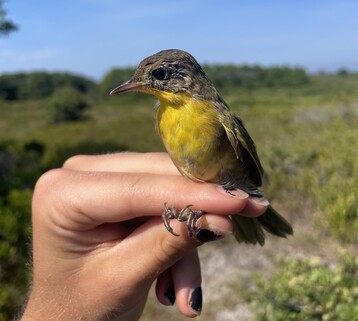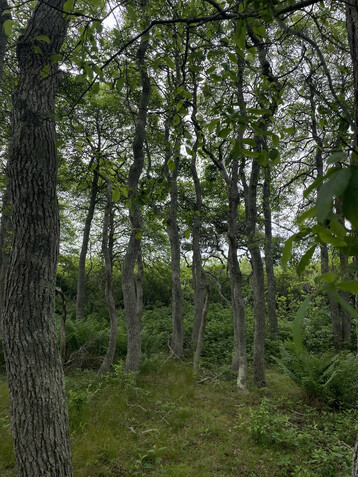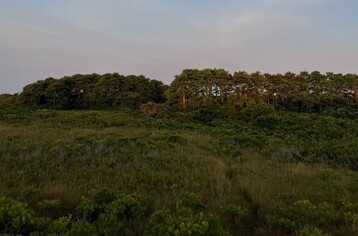Current Nature: Black Tupelo Beauty
Lucas Leasure, Ecological Education Intern, Linda Loring Nature Foundation •

Attending The Ohio State University, I spent much of my undergraduate experience working in the hardwood forests that dominate the East Coast, walking under towering black cherry trees in a forest that would seem to continue forever. It was a memorable shock when I arrived at Nantucket and those same 60-foot-tall, thickly barked trees were here in a completely new form.
Small, wind-whipped with thin, light trunks, the black cherry trees on the island have adapted to survive in this coastal ecosystem, withstanding the constant disturbance of the wind and salt spray.
Now don’t get me wrong, throughout my summer here, I have fallen in love with the wide, farreaching sandplain grassland that Linda Loring Nature Foundation oversees. The bayberry, with its multi-stem and clonal root structure, evolved for the loose, sandy soil it resides in. Bracken fern, with its stretched-out fronds, efficiently capturing water in preparation for hot, sunny days.
I often stop and look at the vastness of our sandplain grassland; how on a clear day you can see acres of land: deer running, harriers swooping, and the North Head of Lond Pond glistening in the sun. However, there is always a place in the back of my mind where I am thinking of the forest.
It is no wonder, then, that when LLNF approached me and offered me their support to complete an independent research project, I ran towards the trees. In Ohio, black tupelo (Nyssa sylvatica) is a common understory plant, often dominated by the oaks, hickories, maples, or beeches that out-compete the slow growing tree.
You can imagine my surprise then, when I learned that there are three small stands of black tupelo on LLNF property, and I had the luck to be working in one of them my first week. “Dr. Seuss looking trees” they were fondly described to me, and I can’t say there’s a more apt description. With their thin, squiggly form allowing the eye to see far into the stand while still feeling the quiet enclosure of the forest, the black tupelo stand was quite unique.

For an area that has an average radius of only 23.5 meters, this small stand has immense character. The thin branches covered in sharp tipped leaves with the dense understory of cinnamon fern, sweet pepperbush, huckleberry and starflower, the woodland habitat contrasts heavily against the surrounding grassland ecosystem. As soon as I stepped in, I knew this was where I wanted to spend a large portion of my summer.
Now that I had my setting, it was time to decide exactly what I would be researching. It took some time, but after participating in one of LLNF’s bird banding sessions and working with our local songbird species, I found my subject. I established three research questions: what is the composition of avian species utilizing the stand? What is the vegetative composition of the stand? How are avian species utilizing the vegetation in the stand? In simpler terms, what plants are there? What birds are there? And, how are the birds using the plants?
The next two months were a flurry of early mornings and data analysis-filled afternoons. During this time, I conducted four methodologies. First, I completed vegetation surveys to understand what vegetation dominated the canopy and the forest floor. Second, I conducted wildlife acoustic recording and monitoring, establishing a baseline of species that were present in the stand based on 24/7 vocalization recording. Next, I conducted various point count surveys, silently watching, listening, and recording what avian species were present and what they were doing. Lastly, I completed two bird banding sessions, banding the birds moving throughout the stand, recording data on species, sex, age, and more.

What I found was no surprise. The black tupelo stand acts as an important habitat, breeding ground, and food source for the local avian population. Black tupelo makes an excellent cavity nest for our den nesting birds, such as the black-capped chickadee and our woodpeckers. As black tupelo ages, the top of the trunk begins to decay and hollow out first, allowing a nest to be built while the base remains secure. Additionally, black tupelo produces an abundant amount of fruit in the late summer and fall, providing growing young birds and hard-working adults nutrients as they prepare for their migration. Furthermore, black tupelo is an important host site for numerous species of moths. There were many times I caught sight of an American robin with a beak full of inchworms for breakfast.
In total, 20 species of birds were identified to be utilizing the stand located on LLNF property. The most dominant species present were the gray cat bird, yellow warbler, blackcapped chickadee, and common yellowthroat. While their populations weren’t abundant, my surveys also revealed the presence of the downy woodpecker, cedar waxwing, and a baby barn owl, three key species that rely on wooded areas for habitat and food.
In drawing things to a close, the stand also acts as a major breeding area, producing young for at least seven species, including: the grey cat bird, eastern towhee, common yellowthroat, American robin, black-capped chickadee, song sparrow, and yellow warbler.

Coming into this research project with no avian background, it was a daunting task to undergo, and an impossible one if not for the support that LLNF staff provides. Whether it was helping me with bird identification, sorting through data analysis, or simply someone to work with halfawake at sunrise, LLNF staff creates a welcoming environment full of comradery, allowing exploration, independence, and the mistakes that come with it.
As I return home, I will miss the black tupelo stand and think of it often. Fall will come, the leaves a bright crimson and orange and the fruit dark and blue. Winter will come, the branches bare, light streaming in strong, uninhibited. Spring will come, leaves re-emerging, birds returning, nests growing. Then, it will be summer, and the black-capped chickadee will sing, the yellow warbler will chirp, the downy woodpecker will drum, the gray cat bird will call and at night, the barn owl will screech.
Stay tuned for more editions of Current Nature, a bi-weekly column featuring seasonal topics, natural history information, and advice on the outdoors from the staff at the Linda Loring Nature Foundation.